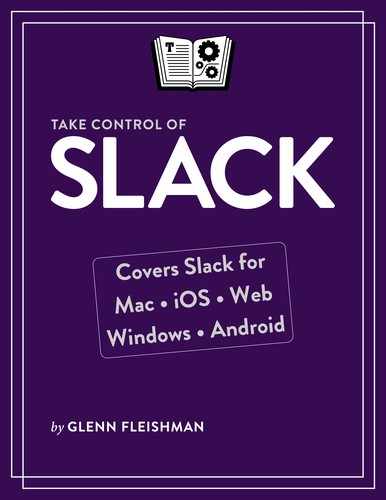Read Me First
Welcome to Take Control of Slack, version 1.1, published in December 2019 by Take Control Books. This book was written by Glenn Fleishman and edited by Kelly Turner and Joe Kissell.
This book teaches you the ins and outs of using Slack efficiently and effectively—and joyfully. It explains how to find channels, start conversations, post messages, set notifications, interact with bots, and more. It covers Slack on the web and in macOS, Windows, iOS/iPadOS, and Android. In the appendix, you learn the basics of administering a Slack workspace.
If you want to share this ebook with a friend, we ask that you do so as you would with a physical book: “lend” it for a quick look, but ask your friend to buy a copy for careful reading or reference. Discounted classroom and Mac user group copies are available.
Copyright © 2019, Glenn Fleishman. All rights reserved. Some avatar images © Design Dept. Partners, LLC.
Updates and More
You can access extras related to this ebook on the web (use the link in Ebook Extras, near the end; it’s available only to purchasers). On the ebook’s Take Control Extras page, you can:
Download any available new version of the ebook for free, or buy any subsequent edition at a discount.
Download various formats, including PDF, EPUB, and Mobipocket. (Learn about reading on mobile devices on our Device Advice page.)
Read the ebook’s blog. You may find new tips or information, as well as a link to an author interview.
If you bought this ebook from the Take Control website, it has been added to your account, where you can download it in other formats and access any future updates. However, if you bought this ebook elsewhere, you can add it to your account manually; see Ebook Extras.
Slack Terms
Slack uses a number of particular terms for aspects of its ecosystem that you will encounter again and again in this book and in using Slack. Here are the most common:
Conversations: Slack is effectively a collection of “chat rooms,” each of which is either a channel or a set of direct messages between two or more people. Collectively, these are conversations.
Members: Someone with a registered account that’s part of a Slack workspace.
Workspace: A single set of Slack conversations and members is a workspace. Some large companies have many workspaces linked together via a high-end, paid Slack service tier. Most Slack setups consist of a single workspace as part of a “Slack for Teams” tier.
Groups: To have a generic term to refer to all Slack tiers, I’ll use the phrase “Slack group.”
Single-channel guests: Members whose access is limited to a single channel (applicable only to paid plans).
Multi-channel guests: Members whose access is limited to a selected set of channels (applicable only to paid plans).
@mention: Slack lets you tag other people using a display name (see next) or their full name so that they can opt to be notified about you referring to them. I use “@mention” in the text to mean whenever Slack allows or expects an @ sign followed by someone’s name.
Display name: A different way for people to @mention you in Slack than your full name. If this option is left empty at signup and never changed, then when people @mention you, Slack relies on your full name. The display name also appears in your profile.
What’s New in Version 1.1
Slack never stands still. The company believes in continuous improvement, often appearing in tiny but comprehensive ways, like changing icons throughout all the apps. This version of the book incorporates all the hundreds of minor changes in language and appearance across the several platforms on which Slack makes software available.
Slack also rolls out larger changes frequently. Just as I was working on updating this version of the book, Slack entirely changed its message text-styling approach and appearance! (See Write a Message for the full, up-to-date details!)
Some other major changes in 2019 covered in this update include:
Multi-image and multi-file uploads make adding items to a Slack workspace simpler. See Upload a File.
Slack desktop apps now use the web app to ease sign-ins. The “magic link” formerly used to aid logging in to a desktop app is now only available for mobile apps. See Sign In to a Workspace.
Dark mode support was added to iOS, iPadOS, and Android apps. See Deploy Dark Mode.
In paid teams, channels can be shared between two entirely separate organizations or companies, a feature formerly in beta testing. See Find and Create Shared Channels.
Unrelated to Slack, Apple split its mobile operating system, iOS, into two nearly identical, separately named systems. iOS 13 runs on the iPhone and iPod touch; iPadOS 13 covers all iPad models that can accept updates. The book has been updated to reflect Apple’s nomenclature change, but the differences between Slack in iOS and iPadOS remain almost nonexistent.
